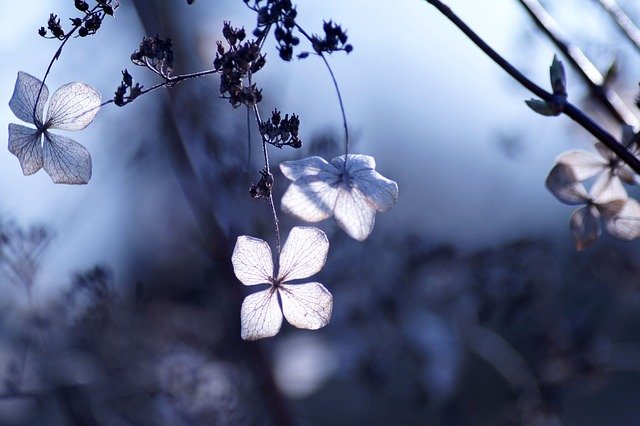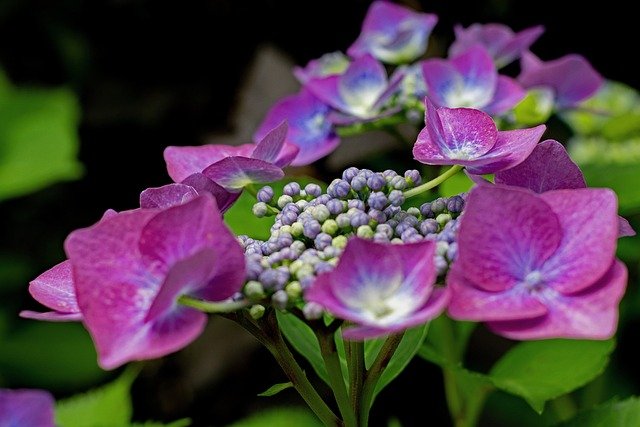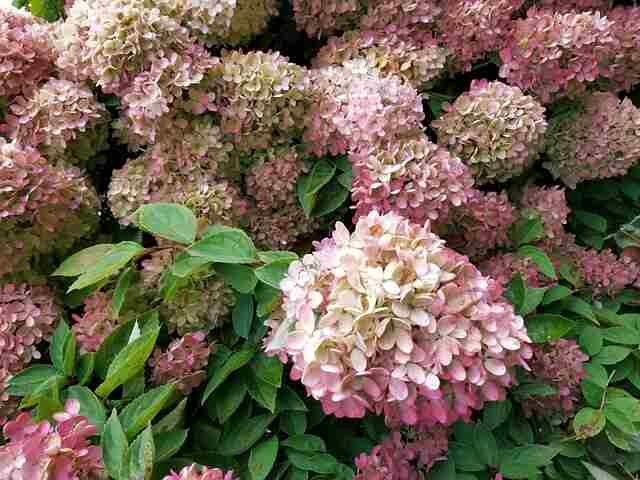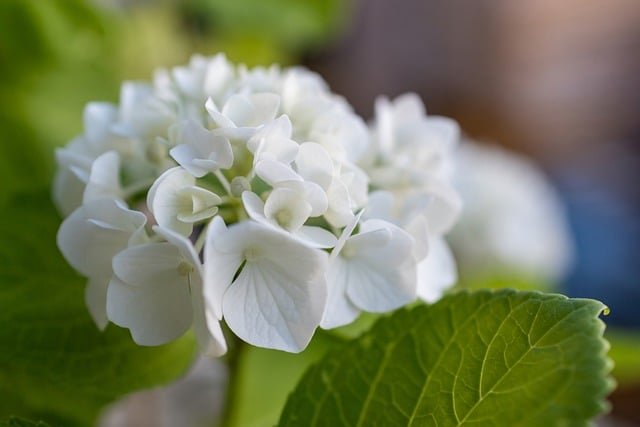Hydrangeas are so common, especially Hydrangea macrophylla. You can buy it even at the grocery store, but at the same time, I find them to be one of the most tricky, one of the most challenging plants to grow in pots. So today, I want to share with you a few tips on how to grow them successfully in containers and to focus especially on why your hydrangeas are not blooming.
There are about 23 hydrangea species, and out of those 23 species, we can talk about 5 types of hydrangeas that are most commonly grown by gardeners, and it’s really important that you know what type of hydrangea you have because not every hydrangea requires the same maintenance, not every hydrangea will be pruned the same way, and not every hydrangea is suitable for a balcony garden.
Hydrangea Arborescens
So let’s talk about those five types of hydrangea to help you identify your plant better and also to point out some differences between these types. First type of hydrangea is Hydrangea arborescens, which is also called wild hydrangea. They are great for a full shade situation or for part shade situation; they produce massive white blooms, some cultivars produce pink blooms as well, but most of the time you will see them as very rounded big white blooms. Some common cultivars are Annabelle, Invincibele, or Incrediball.
Hydrangea Petiolaris

Next is Hydrangea petiolaris, it’s a climbing hydrangea. I see a lot of balcony gardeners buy this plant although it’s a very large vine, so do keep that in mind that at some point it may become too large for your balcony. It’s a great plant for a shady garden, especially if you have a real garden, so if you were to grow it on the north-facing wall of your house, that would be a perfect situation but in a balcony garden situation it can become a little bit too large after a few years. Also, they are sold as very young plants usually, so you may need to wait 2-3 years before the plant establishes and before it becomes a bit more mature and only then it will start to produce flowers.
Hydrangea Macrophylla

Third type of Hydrangea is Hydrangea macrophylla, which is this one, and it’s the one that poses the most problems. They are divided based on the shape of their blooms, we have so-called mophead Hydrangea, because the blooms are really rounded and really full, there’s also Hydrangea serrata which is a mountain type of hydrangea, which I have just in the back, the flower head is a little bit more flat with sterile flowers all around and small fertile flowers in the center and very similar to this one also with a very flat inflorescence is Hydrangea macrophylla normalis, mophead Hydrangeas I noticed they grow fairly slow in pots, but for example mountain hydrangea , it grows really really rapidly and it gets really really large so pay attention to the size of the plant at maturity when you buy them because it can get a little bit too large if you buy a full-size hydrangea. There are some smaller cultivars so if you have a small balcony garden definitely pay attention to what is written on the plant tag and choose some smaller cultivar that you will be able to enjoy for many years.
Hydrangea Paniculata

Fourth kind of Hydrangea will be Hydrangea paniculata which I have here. Hydrangea paniculata as the name says it has panicle-formed blossoms. I can’t show you right now since they sprout somewhat later in the season mid-summer and it seconds ago begins to create blossom buds this kind of hydrangea is presumably the simplest regardless of how you manage it how you prune it or anyway you deal with it in all likelihood it will sprout so most certainly to begin with hydrangea start with Hydrangea paniculata yet here additionally focus on the size at development since there are a few truly huge cultivars yet for overhang gardens there are some bantam cultivars for instance here I have ‘Little Lime’ there’s too “Bobo’ hydrangea there is hydrangea ‘Polestar’ so these are a portion of the more modest cultivars that are more reasonable for gallery and for holder gardens. One thing about Hydrangea paniculata is that it would favor somewhat more radiant area so as I said the hydrangea arborescens and hydrangea macrophylla they can be filled in full shade or to a limited extent conceal yet hydrangea paniculata wouldn’t be guaranteed to flourish in a full shade circumstance so assuming that you have a more bright area this will be great.
Hydrangea Quercifolia
The last Hydrangea will be Hydrangea quercifolia which is an oak leaf hydrangea so as the name says it has leaves that look like those of an oak tree and sprouts look like those of hydrangea paniculata. Try not to commit error between these two since they are totally various species that should be kept up with in an unexpected way, however Hydrangea quercifolia likewise partakes shortly more radiant area. So since it is now so obvious those five hydrangea types we can partition them into those that sprout on new wood and those that blossom on old wood and that is the main data in light of the fact that in view of that you will know how to appropriately prune your hydrangea. So what’s the significance here that hydrangea sprouts on new wood versus on old wood?
I have my Hydrangea paniculata, and both Hydrangea paniculata and hydrangea arborescens blossom on new wood so this year in spring it creates new branches it delivers new stems and on this new stems as it will deliver its sprouts so Hydrangea arborescens you can slice it the whole way to the ground you can cut it either in fall or in spring as you like with hydrangea paniculata you would need to leave a smidgen of those woody stems so you cut you would scale it back by about half or 66% relying upon the size of your plant and in spring it’s about to leaf out, it will create new shoots new branches and on these branches it will sprout. Running against the norm Hydrangea macrophylla, Hydrangea quercifolia and Hydrangea petiolaris sprout on old wood so it implies that they produce their blossom heads on the wood so on the branches from last year so in spring this plant awakens and it needs quickly to sprout it won’t deliver new development like this one it’s about to awaken it will leaf out and it will sprout. So assuming that you cut back this kind of hydrangea in fall particularly Hydrangea macrophylla on the grounds that a ton of hydrangea macrophyllas they just produce their blossom buds on apical buds on terminal buds so it truly intends that assuming that you cut those terminal buds off in fall or in spring you’re removing expected sprouts. the vast majority of the times when somebody reaches me and tells me “hello my hydrangeas are not blossoming do you know the motivation behind why?” Normally it’s Hydrangea macrophylla that has been pruned in fall or in spring so assuming you do it you cut off likely blossoms and it’s never going to sprout for you. So one guidance here – in the event that you don’t have the foggiest idea what kind of hydrangea you have improved leave it unpruned, no plant has at any point experienced being unpruned for a season or two since when you don’t prune it – you don’t risk anything.
If for whatever reason you have to do it you have a very very short window so you have to prune it immediately after it’s done blooming so that’s mid-summer if you prune it in fall or in spring you are cutting of potential blooms. So now that you know how to prune or not prune your hydrangea, let’s talk about some other possibilities why your hydrangeas are not blooming. Usually the number two reason is due to inconsistent watering and inconsistent feeding. Hydrangeas are thirsty and they are hungry plants and as long as when they are planted in ground they can spread their roots in search for water and nutrients they can’t do it in a pot, they live in a restricted environment and they only have as much as you give them.
So you have to water them really really often and abundantly hydrangeas do not like to be dry, they like the soil to be constantly moist and in summer you will probably need to water your plants every single day. Secondly, you have to feed your hydrangeas because they put on such a beautiful show they need to have energy in order to do it just like humans we need to feed ourselves well to be able to perform well to have energy it’s the same for plants they need nutrients in order to bloom so abundantly and to perform so beautifully and so healthy so when you grow them in pots I suggest that you use liquid feed I think that’s the most convenient way of fertilizing your hydrangeas. I’m fertilizing my hydrangeas from the moment when I see flower buds appearing and I give them Alga Bloom which is an organic seaweed fertilizer it’s a compound NPK fertilizer for flowering plants and I give them this fertilizer about once a week, another thing that I give to my plants is this additive Green Sensation it’s potassium and phosphorus-based additive so it’s like an additional booster that improves soil it improves plants resistance and it also promotes abundant flowering. Okay, and a few last words about maintenance and repotting.
I repot my hydrangeas probably every 2-3 years, people often ask me what is the size of the pots of my hydrangeas or other plants and I must say I first of all I never really pay attention to the actual size of the pot I judge everything by eye I look at the size of the plant and I consider its maturity and based on this I choose a pot so when you bring a plant from the garden center check what is the size of the container that it’s in and repot it into a pot one size or two sizes bigger. If you chose a dwarf variety at some point you will not need to repot it, it’s only with the plants that continue to grow like for example my hydrangea serrata and my hydrangea macrophylla they’re quite large cultivars so I’m repotting them into increasingly bigger pots but for example my Hydrangea ‘Little Lime’ which is a dwarf variety it’s in its final pot I’m not gonna report it into any bigger pot because it reaches a certain mature size and it’s then not gonna keep growing so you don’t have to repot it into bigger and bigger pot. As for soil – I’m planting all of my hydrangeas in universal potting mix the same that I use for other plants they do prefer their soil to be slightly acidic but in my opinion it’s better to buy a good quality universal potting mix rather than to buy a poor quality ericaceous potting mix of course if you can find a good quality ericaceous potting mix so a potting mix that is suitable for plants that like acidic soil then go ahead and plant your hydrangeas in an ericaceous compost but you can plant them in universal as well and they will do perfectly fine.
Hydrangeas are winter hardly plants so theoretically you don’t have to protect them from frost but be very careful in if you live in a colder climate in spring when the temperatures start to warm up your hydrangeas start to wake up and then if a sudden frost comes it can damage your plants especially hydrangea macrophylla as we said they bloom on old wood so if they start to produce their buds and then sudden frost comes in and it damages the buds then your hydrangea may not flower that year okay so that’s it for today’s article I hope that you learned some useful tips on how to grow hydrangeas in pots .



